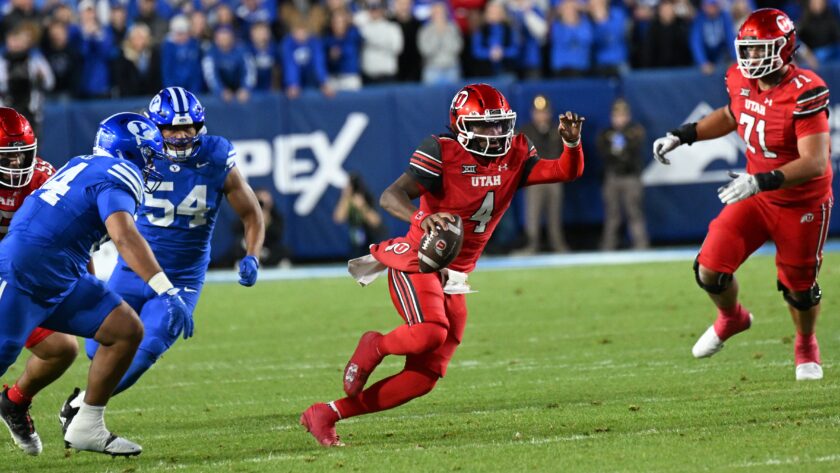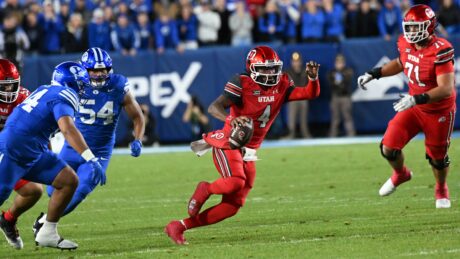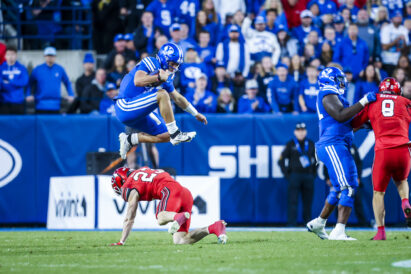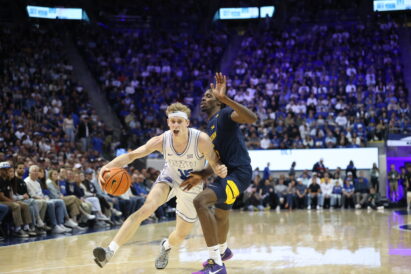BYU-Utah Notebook: Whittingham goes with analytics instead of field goals in rivalry loss

Harold Mitchell, Special to the Herald
Utah quarterback Devin Dampier runs with the ball in a Big 12 college football game with BYU in Provo on Saturday, Oct. 18, 2025.At the new conference after his team’s 24-21 loss to BYU on Saturday, Utah head coach Kyle Whittingham was quick to point out the statistical edge the Utes had in many categories.
In fact, Utah had more than 100 total yards of offense than BYU (470 to 368), more first downs (24 to 22) and even had a higher third down conversion rate (5-for-12 vs. 3-for-12). Whittingham pointed to the two turnovers the Utes had while the Cougars had none, the inability to convert on fourth downs going 1-for-5 while BYU was 1-for-3, and the general lack of efficiency his team had in the red zone as the key elements leading to his team’s defeat.
But the reporters, like many Utah fans, wanted to know why the Ute head coach passed up kicking short field goals in a game most figured would be a tight, low-scoring contest. Whittingham said it came down to one thing — analytics.
“We were well inside the analytics to go — three yards inside the analytics — so unless you tell me to go against the analytics, that’s why,” Whittingham said.
Of course, the follow-up question was asked if one should adjust that given the game and the match-up and Whittingham quickly responded, “No.”
Still, there was the one curious decision where Utah looked ready to kick a field goal on a fourth-and-seven situation and just before the snap, BYU called time out. During the time out, Whittingham decided to go for it, saying, “analytics said to go for it there as well. We were going to kick it initially, but we had a change of heart.”
Coaches using analytics has become a significant element in modern sports. And at the heart of analytics are complex mathematical principles that coaches can rely on to make strategic decisions. In football, one of the biggest aspects of analytics use has led coaches to forgo field goals and punting to go for first down or touchdown conversions.
The use of analytics first took hold in baseball and were popularized in the movie “Moneyball” starring Brad Pitt as then Oakland A’s general manager Billy Beane. But even Beane recognized their use had limitations, suggesting that their strength lay in their use over an arc of a long season but short series and individual games were a different animal.
In regards to this year’s MLB playoffs, the Los Angeles Dodgers have decided to buck the analytic trend by having their starters go deeper into games where analytics has suggested, giving hitters a crack at seeing a pitcher three times which can lead to worse results than going to the bullpen.
BYU head coach Kalani Sitake passed up kicking a field goal late in the game that could have forced Utah to score two touchdowns to win the game versus a touchdown and a field goal to tie. Sitake said on his post-game radio appearance, “The analytics said to kick the field goal, but I didn’t want to.”
Extra points: BYU wide receiver Chase Roberts extended his streak of having at least one reception in a game to 33 games. … Cougar defensive end Hunter Clegg registered his first career sack, as did linebacker Max Alford. … Though some flags were thrown on BYU toward the end of the game for pass interference, BYU was penalized just five times for 42 yards and had zero penalties in the first half. Meanwhile, Utah was penalized 12 times for 77 yards with one of those being a critical roughing-the-passer penalty with targeting which led to the ejection of linebacker and captain Lander Barton. … BYU sophomore safety Faletau Satuala had 12 total tackles with eight of them being solo. He also was credited for one tackle for loss and pass defended. Senior safety Tanner Wall had 10 total tackles including one for a loss and secured an interception in which BYU converted into a touchdown. … BYU welcomed back linebacker Jack Kelly from injury. Kelly added seven tackles and a sack. … Cougar running back LJ Martin went over 100 yards rushing for the second straight game as he rushed for 122 yards on 26 carries. … Both quarterbacks showed their running skills. BYU’s Bear Bachmeier had 64 yards on 11 carries for a 5.8 yards per carry average while Utah’s Devon Dampier also had 64 yards rushing on 15 carries for a 4.3 yards average. … Cougar captains for the coin toss were Kelly, Roberts, Wall and defensive tackle (and former Ute) Keanu Tanuvasa. … Utah won the coin toss and deferred their choice to the second half. BYU is now 5-2 in coin toss success in 2025 but has lost the toss in the past two games. … Carrying out the BYU team flags were tight end Noah Moeaki (USA), defensive end Tausili Akana (State of Utah), and defensive tackle Kaufus Pakofe (Big 12). … The alumni flags were carried by John Moeaki (linebacker, 1994), Mike Uluafe (defensive lineman, 1993-95) and Henry Bloomfield (defensive line, 1994-96). … Gail Miller, philanthropist and wife of former Utah Jazz owner Larry H. Miller, lit the Y before the game… BYU wore blue jerseys with blue pants, and instead of the customary white jersey for the visiting team, Utah wore red jerseys with red pants as this has become routine in this rivalry game. … The BYU and Utah marching bands played together at halftime. … Attendance was 64,794, the largest LaVell Edwards Stadium crowd since BYU hosted Notre Dame in 2004.



